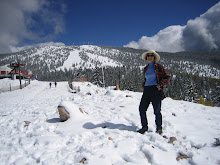TREASURES OF NEW MEXICO - PART ONE

After traveling to India, France, Mexico, Zion National Park and Death Valley, I was weary of being far from home. “Why go to the ends of the earth?” I asked myself. “There’s much to see right here.” Accordingly, I set my sights for southern New Mexico.
Originally from Virginia, I’ve lived in Santa Fe since 1967. As a “semi-native,” I had no excuse not to know more about my chosen state. My travel companion, Peter Dechert, is a photographer and also a longtime New Mexico resident. For him, everywhere offers lovely, interesting photo opportunities. In the spring of 2008, we agreed that it would be fun to spend an old-fashioned Fourth of July weekend in Silver City. It’s about five and 1/2 hours south of Santa Fe.
En route we visited the Very Large Array (VLA) south of Socorro on the Plains of San Augustin. The drive to VLA offers big, beautiful cloudscapes in a dazzling blue sky; high desert plateaus and the distant Gallinas Mountains. The terrain’s stark emptiness is amazing: very few cars, vast stretches of unpopulated land, dramatic panoramas in every direction.
The VLA: long before reaching them, one sees the gargantuan radio telescopes. From a distance, they resemble huge insects just landed from outer space. As we drive closer, the “insects” look more like what they are: fantastic dish antennas, 27 in all. Our guidebook states that each weighs 230 tons and measures 82 feet in diameter. Apparently the 27 telescopes move on railroad tracks to focus at the same time on one area of the sky. Enabling a colossal survey of the heavens, radio impulses are transferred to photo images.
The VLA is astonishing and well worth a couple hours to walk around outdoors and also to visit the small but fascinating information center. Inside the center, we view displays explaining how the telescopes collect data from the celestial universe. We learn that their operators comprise scientists from around the globe who perform 50 experiments a month.
Among the exhibits are amazing photos of our galaxy and galaxies beyond, far-flung stars, vortexes, fiery plumes and deep blue “pools” in the sky. Several photos are accompanied by quotes from Carl Sagan. His words remind me of how infinitesimal is our planet Earth, how tiny are we humans, how we and our lives are but a tiny jot in the vast reaches of time.
One of the best exhibits is a paperback copy of War and Peace next to a flashing pulsar device. The caption explains that a single pulse equates to a volume of information equaling the entire novel. Astonishing!
“This is really hard to get my mind around,” I say to Peter. He agrees and suggests that we go back outside for more views of VLA’s “hardware.”
The afternoon is waning. My friend and I enjoy lunch at VLA’s picnic area. Half of the satellite dishes now face east instead of west. The shift took place quietly, without our noticing. Clouds are building toward the horizon and the air feels cool. Sandwiches consumed, we pack up to continue our earthly journey.
Labels: VERY LARGE ARRAY (VLA)







1 Comments:
This site is located near Magdalena, a town that my maternal grandfather passed when he went to look for work in Silver city in the late 1800's. He named my mother Magdalena because he liked the name. She was born in 1903, passed away in 1987. Incidentally I have always liked your pictures in hats. I am an old fashioned old veteran.
Post a Comment
<< Home